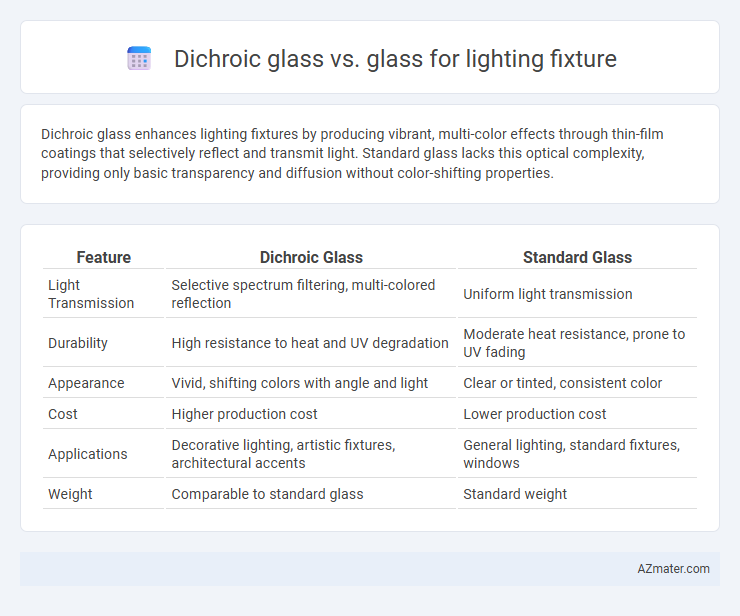Dichroic glass enhances lighting fixtures by producing vibrant, multi-color effects through thin-film coatings that selectively reflect and transmit light. Standard glass lacks this optical complexity, providing only basic transparency and diffusion without color-shifting properties.
Table of Comparison
| Feature | Dichroic Glass | Standard Glass |
|---|---|---|
| Light Transmission | Selective spectrum filtering, multi-colored reflection | Uniform light transmission |
| Durability | High resistance to heat and UV degradation | Moderate heat resistance, prone to UV fading |
| Appearance | Vivid, shifting colors with angle and light | Clear or tinted, consistent color |
| Cost | Higher production cost | Lower production cost |
| Applications | Decorative lighting, artistic fixtures, architectural accents | General lighting, standard fixtures, windows |
| Weight | Comparable to standard glass | Standard weight |
Introduction to Glass Types in Lighting Fixtures
Dichroic glass in lighting fixtures offers unique color-shifting properties by reflecting specific wavelengths of light while transmitting others, creating dynamic and vibrant illumination effects. Conventional glass used in lighting fixtures primarily focuses on clarity and durability, allowing consistent light diffusion without altering the light spectrum. Choosing between dichroic glass and standard glass depends on the desired aesthetic impact and application requirements in architectural and decorative lighting.
What is Dichroic Glass?
Dichroic glass is a specialized material coated with multiple micro-layers of metal oxides that selectively filter and reflect specific wavelengths of light, creating vibrant, shifting colors. Commonly used in lighting fixtures, it enhances aesthetics by producing dynamic color effects that standard glass cannot achieve. Unlike regular glass, which simply transmits light, dichroic glass manipulates light properties for artistic and functional illumination purposes.
Standard Glass in Lighting: An Overview
Standard glass in lighting fixtures offers high transparency and durability, making it a reliable choice for general illumination applications. Unlike dichroic glass, which selectively filters light wavelengths and alters color output, standard glass maintains neutral color rendering and consistent light diffusion. Its cost-effectiveness and ease of manufacturing make standard glass the predominant material in most residential and commercial lighting designs.
Light Transmission and Color Effects
Dichroic glass significantly enhances lighting fixtures by offering superior light transmission with minimal haze, allowing vibrant and precise color effects through its multilayer interference coatings. Unlike standard glass, which primarily diffuses light and provides limited color variation, dichroic glass selectively filters wavelengths, creating dynamic, shifting hues that vary with viewing angle and light source intensity. This unique optical property makes dichroic glass ideal for fixtures aiming to deliver vivid, customizable illumination and artistic light patterns.
Heat Resistance and Durability
Dichroic glass offers superior heat resistance compared to standard glass, making it ideal for lighting fixtures exposed to high temperatures. Its multilayer optical coatings not only enhance durability by resisting thermal shock and environmental wear but also maintain color stability under prolonged heat exposure. In contrast, conventional glass tends to be less resilient to heat stress and more prone to cracking or discoloration over time in demanding lighting applications.
Aesthetic Differences in Lighting Design
Dichroic glass in lighting fixtures offers dynamic color shifts and reflective properties that create vibrant, multi-hued effects, enhancing visual interest and depth in lighting design. Glass for lighting fixtures, typically clear or frosted, provides more uniform light diffusion and subtle aesthetic appeal without color modulation. The distinct iridescence of dichroic glass adds sophistication and a modern artistic element, while standard glass emphasizes clarity and simplicity.
Energy Efficiency and Performance
Dichroic glass enhances lighting fixture energy efficiency by reflecting unwanted wavelengths while transmitting desired light, reducing heat and lowering cooling costs. Its precision in filtering improves lamp lifespan and overall performance compared to standard glass, which absorbs more heat and dissipates less light uniformly. Using dichroic glass in lighting fixtures results in high color purity and increased energy savings due to its superior optical properties.
Cost Comparison: Dichroic vs Standard Glass
Dichroic glass lighting fixtures typically cost 20-30% more than standard glass due to their complex manufacturing process involving multiple thin-film layers. Standard glass is more affordable, with prices driven by simpler production and material availability, making it a cost-effective option for budget-conscious projects. The higher initial investment in dichroic glass often balances out with enhanced color effects and durability, potentially reducing long-term maintenance expenses.
Best Applications for Dichroic Glass
Dichroic glass excels in lighting fixtures by providing vibrant, multi-colored light effects through its specialized thin-film coatings that selectively reflect and transmit specific wavelengths. It is best applied in architectural lighting, theater, and stage design where dynamic color-changing illumination enhances ambiance and visual impact. Unlike standard glass, dichroic glass offers superior color stability and precision, making it ideal for high-end decorative lighting and art installations.
Choosing the Right Glass for Your Lighting Needs
Dichroic glass offers vibrant, color-shifting effects ideal for decorative and artistic lighting fixtures, enhancing ambiance with dynamic light reflections. Standard glass is more affordable and provides clarity and durability suitable for general lighting applications requiring consistent light diffusion. Choosing the right glass depends on the desired visual impact, budget, and lighting environment, with dichroic glass excelling in aesthetic appeal and standard glass delivering functional reliability.

Infographic: Dichroic glass vs Glass for Lighting fixture
 azmater.com
azmater.com